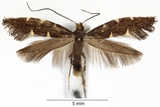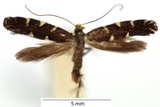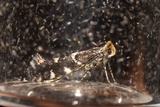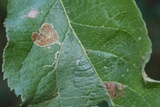Callisto denticulella (Thunberg, 1794) Species
Last modified: Dec. 14, 2024, 2:57 p.m.
A fairly common species in Belgium, its presence mainly recorded from leaf mines, not so often seen in the adult stage.
Details
- Classification
- Family: Gracillariidae > Subfamily: Gracillariinae > Tribus: Parornichini > Genus: Callisto > Species: Callisto denticulella
- Vernacular names
- Roestmijnmot (NL), Garden apple slender (EN), Apfel-Blattrandminiermotte (DE)
- Synonyms
- Callisto guttea (Haworth, 1828) and Callisto guttiferella (Duponchel, 1840)
- First mention in Belgium
- De Sélys-Longchamps E. 1844. Énumération des insectes Lépidoptères de la Belgique. — Mémoires de la Société royale des Sciences de Liége 2: 1–35. On page 25 (as guttiferella). view page
- Status
-
Native
Distribution
Caterpillar
Yellowish green with dark brown head capsule.
Mine
At first a very small, inconspicuous gallery, mostly but not exclusively at the upperside of the leaf. Later instars make a semicircular or oval blotch mine, sometimes partly or completely covering this gallery. The blotch is greyish white at the beginning but soon turns into orange-brown, except when it is an underside mine where the original color is kept.
See also gracillariidae.net and bladmineerders.be.
Bionomics
Only the first instar keeps its frass in the narrow gallery, but the following instars eject the frass from the blotch mine. The free-living caterpillar turns a leaf edge downwards and spins it into a fold under which the larvae feed. Usually, two such folds are made during the entire life cycle.
Pupation in a folded leaf edge among leaf litter.
Hibernation in the pupal stage.
Adults hide among the foliage during daytime. They are not very active but come to light.
Flight periods
The adults fly in one generation a year from the end of April till the end of June.
Observed on
- Host plant (species):
- Malus sylvestris and Malus domestica
- Host plant (genera):
- Malus
The caterpillars feed mainly on Malus, both wild species and many cultivars. Mines have also occasionally been recorded from other Rosaceae species, like: Pyrus, Crataegus and Cotoneaster.
Habitat
Old orchards and gardens with apple trees.




